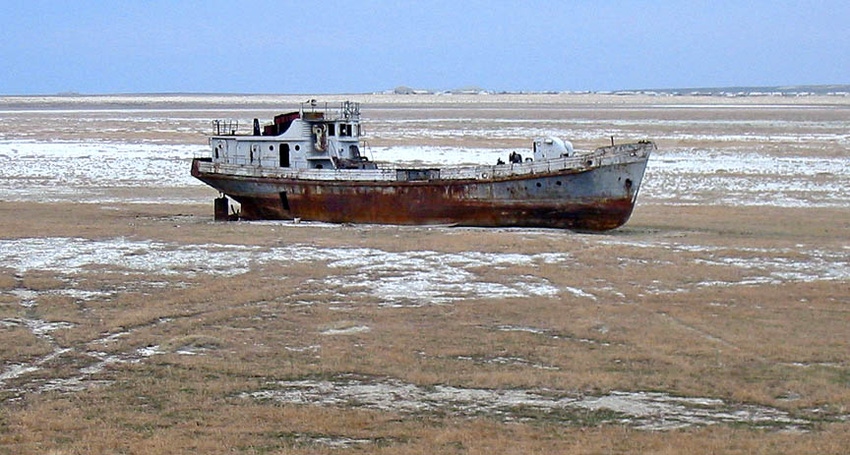January 29, 2014

The Aral Sea, once the size of Ireland, has almost vanished in an absolute environmental horror show. The Aral’s disappearance is a benchmark reminder that water choices have pay-to-play consequences: Suck out enough water and the well goes dry.
Once the fourth largest lake on Earth covering an area of 26,300 square miles, the Aral Sea has been choked since the 1960s to roughly 10 percent of its original size. Left behind is a scarred, parched plain — a saline stretch of dust devoid of life, yet teeming with toxicity. Even the rusting ship hulls stranded as the waterline receded are now gone, broken up and hauled away for scrap metal. It’s an extreme testament of bitter irony when a body of water once acclaimed for its fishing industry yields scrap metal instead of fish.
See related: Where is one-fifth of the world’s fresh water hiding?
Landlocked between Kazakhstan and Uzbekistan, the disappearing act began during Nikita Khrushchev’s rule in the 1960s when the Soviet Union diverted the Aral’s only two water sources — the rivers Amu and Syr, but the Aral Sea had been doomed since 1919, when Lenin “decreed that the Soviet Union should become self-sufficient in cotton production,” according to LibArts London. When Stalin next took over and agricultural collectivization exploded, tremendous amounts of irrigation were needed for massive tracts of acreage. As the Amu and Syr were diverted, and cotton production began booming south of the Aral Sea, a disaster with tremendous environmental, social and economic repercussions was setting in.

The Soviets were stirring an unregulated cauldron of water, pesticide and fertilizer abuse across the region as the Aral Sea immediately began evaporating and shrinking, leaving fishing industry towns stranded and impotent. Salinity of the water escalated; drinking water was contaminated; and plant and animal life simply disappeared. “By 1987 it had divided into two sections, the ‘Small Northern Aral’ and the ‘Large Southern Aral.’ By 2008 only two small lakes remained and the world’s youngest desert, the Aralkum, formed as a consequence.”
Shred of optimism
Despite being reduced to a fragment of its original size, possibly a small portion may be saved. From Vice: “… over the last few years, one of the world’s worst ecological disasters, oddly enough, has been shrouded in some long overdue optimism. In 2003, the Kazakhstani government, along with the World Bank, began work on the joint $85.5 million Northern Aral Sea restoration project … A small fraction of the fishing industry has been revived and water is even starting to creep back towards the old harbor of Aralsk.”
See related: Where is one-fifth of the world’s fresh water hiding?
But the death of the original Aral was inevitable when the consequences of water decisions were ignored. There was no element of surprise to the Aral Sea’s death because the Soviets knew they were turning a body of water the size of Ireland into a desert. They knew the well would go dry — and didn’t care.
Follow me on Twitter: @CBennett71 or email me: [email protected]
*Additional photo courtesy of Staecker, Wikimedia Commons
Blog archive
Big Ag goes organic (Come again?)
Farm’s Nazi past still fresh for slave workers
Farmer privacy breach brings suit against EPA
James Bond once worked for the EPA
AK-47 rifle was agriculture’s giant loss?
What treasure is buried beneath farmland?
Farmer suicide and the road to agricultural ruin
Gun control and agriculture clash over homemade pistol
Farmland hides mobster for 10 years
What are the greatest agriculture breakthroughs in history?
Oil tankers, not icebergs, a water scarcity solution?
The myth of the aging US farmer
Pig farmer replays Deliverance with repo men
About the Author(s)
You May Also Like






